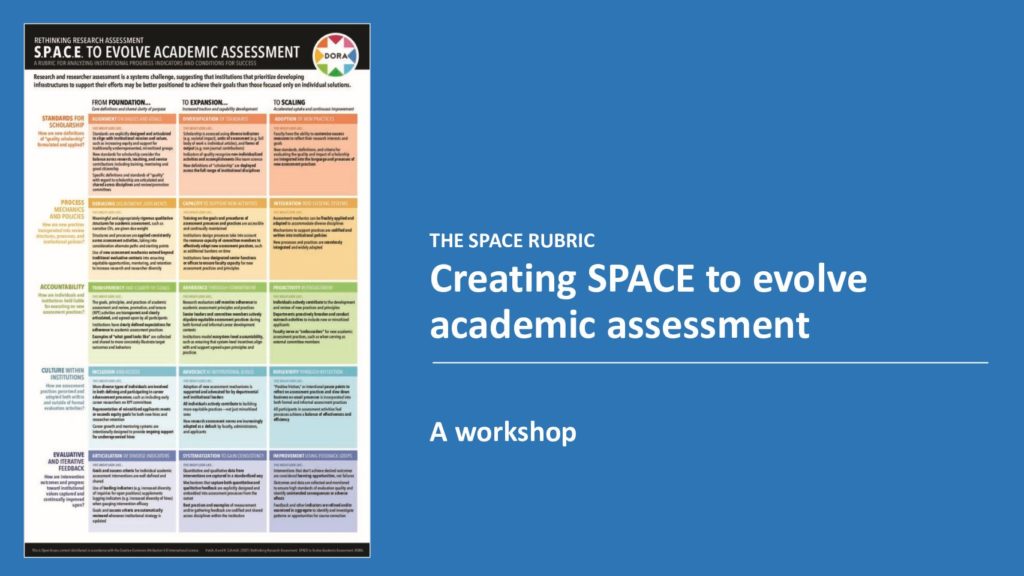This is part of DORA’s toolkit of resources to support academic institutions that are improving their policies and practices. Find the other resources in the toolkit here. With thanks to volunteers in the DORA community, most resources in the workshop kit are also available in Spanish. See below.
This kit is intended to equip organizers with the materials needed to run a version of the DORA SPACE workshop for participants from their academic association, institution, department, and more. It contains a slide deck, pre-workshop materials, and instructions for breakout room facilitators. Workshop organizers can find all of the necessary materials at the “View file” button on this resource page.
Background: What is the SPACE rubric and how can it be used?
The SPACE rubric was developed in partnership with DORA and Ruth Schmidt, Associate Professor at the Institute of Design of the Illinois Institute of Technology, who led the iterative participatory design process. The rubric is a tool to help institutions at any stage of academic assessment reform gauge their institutional ability to support interventions and set them up for success.
Organizations can use the rubric to support the implementation of fair and responsible academic career assessment practices in two ways: First, it can help establish a baseline for the current state of infrastructural conditions, to gauge an institution’s ability to support the development and implementation of new academic assessment practices and activities. Second, the rubric can be used to retroactively analyze how strengths or gaps in these institutional conditions may have impacted the outcomes of concrete interventions targeted to academic assessment activities (e.g., hiring, promotion, tenure, graduate student evaluation).
Workshop materials:
- Slide deck: The slide deck serves as an example of how organizers can structure a 2-hour SPACE rubric workshop. The kit includes an English and a Spanish version of the slide deck. In this example slide deck, which was created by Ruth Schmidt, the workshop is broken down into:
- An introductory section in which organizers outline what the SPACE rubric is and provide a series of examples of how the rubric might be used. This section also contains examples of “real life” lessons from actual rubric users to illustrate how this tool might be used.
- A breakout session in which facilitators guide small groups of participants through key questions based on the SPACE rubric that are designed to stimulate deep discussion about the current state of participants’ organizations and concrete actions to take to implement change.
- A large-group discussion.
- Breakout room facilitator instructions: The facilitator instructions serve as an example of how the SPACE rubric can be used to inform discussion-generating questions during workshop breakout sessions. These questions ask workshop participants to think through key elements to help them frame the current and future of responsible research assessment practices at their organizations. The kit includes an English and Spanish-hybrid version of the facilitator instructions.
- Pre-work: Organizers may choose to share “pre-work” with participants 1 to 2 weeks before the workshop. In the example provided, pre-work is encouraged but certainly not required as its purpose is to “prime the pump” for discussion. The kit includes an English and Spanish version of the pre-worksheet.
- Pre-worksheet: The kit includes a “pre-worksheet” for participants to complete prior to the workshop. The aim of this example pre-worksheet is to 1) help each participant focus on the needs and goals of their specific organization, department, etc., and 2) help each participant capture the current research evaluation strategy at their organization in advance.
- Reading: Participants can be asked to read the article Research Culture: Creating SPACE to evolve academic assessment to help facilitate understanding of what the SPACE rubric is and how it might be used.
- Workbook: After the workshop is concluded, organizers may choose to share the SPACE rubric workbook with participants to help them continue the conversation. The workbook contains a page for each of the five SPACE rubric dimensions, which can be completed independently or in groups to capture specific aspects of current, anticipated, and aspirational institutional capabilities for research assessment reform. Each page also contains illustrative examples of the kinds of activities and behaviors that might be relevant for Foundational, Expansion, and Scaling phases. Finally, the workbook contains a “Next Steps” page for capturing concrete existing and future actions that can help move efforts forward. The kit includes an English version of the workbook, which was created by Ruth Schmidt.
Please reach out to us (info@sfdora.org) if you have any questions about using the workshop kit. DORA is eager to support organizations interested in using the kit to advance fair and responsible academic assessment.
Translations: Spanish translations of the presentation slides were contributed to by Verónica Polanco and Soledad Aravena. Spanish translations of the worksheet were contributed to by Verónica Polanco and Soledad Aravena. Spanish translations of the facilitator guidelines were contributed to by Amanda Akemi, Verónica Polanco, and Soledad Aravena. The translations are made available under the terms of the Creative Commons Attribution International License. We are grateful to the volunteers who produced and checked the translations.


